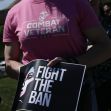The National Coalition for Men is requesting the Supreme Court to consider whether the male-only requirement for Selective Service registration is a violation of equal protection guaranteed under the Constitution.
Currently, most United States citizens and immigrant men between the ages of 18 and 26 must register with the Selective Service System. Registering does not inherently lead to military service and is separate from the draft. The President and Congress must activate the draft for those registered to be considered for military duty.
If the draft is activated, the Selective Service System will conduct a national lottery. Those who are chosen must report to Military Entrance Processing Stations (MEPS) for physical, mental, and moral evaluations. If MEPS deems a person ineligible, they are removed from the roster and will not perform military duty. If MEPS deems an individual eligible, they will either report directly to military training or they will file a claim for deferment or exemption, which are adjudicated by the Selective Service System. If the claim is accepted, the individual must participate in an Alternative Service Program; if not accepted, they must continue to military training.
The National Coalition for Men (NCFM), a 501(c)(3) non-profit corporation, argues that the current system “imposes selective burdens on men, reinforces the notion that women are not full and equal citizens, and perpetuates stereotypes about men’s and women’s capabilities.” Founded in 1977, NCFM states they are “committed to ending harmful discrimination and stereotypes against boys, men, their families and the women who love them.” Their mission statement states they are a nonpartisan organization.
NCFM initially raised the lawsuit against the Selective Service System in 2013 in the United States District Court for the Central District of California, where it was dismissed. However, in 2016, the Ninth Circuit Court of Appeals reversed that decision and remanded the case back to the district court. The case was then transferred to the U.S. District Court for the Southern District of Texas where in February 2019 Judge Gray H. Miller declared that the male-only registration requirement is unconstitutional. The current petition for a writ of certiorari, or the request for the Supreme Court to review the case, was filed on January 8, 2021, by the American Civil Liberties Union, on behalf of NCFM.
In 1981, the Supreme Court ruled in Rostker v Goldberg that the Military Selective Service Act withstood the constitutional challenge of a male-only registration system. At the time women were prohibited from serving in combat roles, and the Court noted the main purpose for registering individuals was to replace combat troops in a national emergency. However, in 2013, this ban on women in combat roles was lifted. This shift, in the eyes of the NCFM, nullifies the Supreme Court’s 1981 main argument upholding the right of the Military Selective Service Act to conscript only men.
The United States has had a contentious history with the use of the draft and who is required to register. The first time the United States drafted men into military service was under the Civil War Military Draft Act of 1863. It required all men between the ages of 20 and 45 to perform military service. However, wealthy men were able to either find a replacement for their service or pay the $300 draft exemption, therefore giving poor men a larger burden of military service. United States presidents have enforced conscription during both World War I and World War II. In preparation for the U.S. to enter World War II, the first peacetime draft registration was enacted, expanding the age range significantly, and by 1943 also registering African Americans to fight. The last time the United States enforced the draft was in 1972, during the Vietnam War, which was also the height of opposition to the use of conscripted service in the United States.
The opposition to conscripted service has had just as long of a history as the draft itself. The first draft riots occurred in New York in July 1863 with over 199 people dying, many of them poor Irish immigrants. The next wave of opposition didn’t occur until the late 1960s as the United States was deep in the Cold War. Not only were draft riots breaking out, but dodging the draft became a viable opportunity for men not wanting to serve. Canadian immigration statistics showed that in the 1960s, approximately 30,000 American men crossed the border into Canada to evade the draft.
Failing to register with the Selective Service System holds steep penalties, just as dodging the draft does should the President enact it. Men who evade registering are not eligible for federal student loans, may face criminal prosecution, are disqualified from many jobs, and immigrants may be disqualified from obtaining U.S. citizenship. In NCFM’s petition, they argue that this burden should be shared by men and women alike.
The National Commission on Military, National, and Public Service, a congressionally mandated commission tasked with researching and proposing recommendations for the future of the military and public service, published its final report on March 25, 2020. The Commission “explained by burdening only men while excluding women, the Military Selective Service Act ‘sends a message’ that women ‘are not vital to the defense of the country.’” The Commission recommends that the Military Selective Service Act be amended to include all individuals of the applicable age cohort, therefore renewing NCFM’s fight to include women.
Interestingly, “all individuals of the applicable age cohort” include more than just what the NCFM is arguing at face value. According to the Selective Service System, there is another group of individuals not required to register. Any U.S. citizen or immigrant who has changed their gender from male to female is required to register. However, the opposite is not true. Any individual who transitioned from female to male is not required to register. Therefore, in some instances, there are already some women who are required to register when they turn 18, while there are some men who are not required to register at all.
Throughout its history, NCFM has received criticism from groups such as the Southern Poverty Law Center (SPLC), for “cherry-picking” statistics and issues to “create false equivalences between the oppression of men and women, rather than simply seek to advance the cause of men and fathers.” SPLC further claims that NCFM “offer[s] little help to men other than blaming women.” While the argument to require women to register with the Selective Service System is not inherently a sexist claim, especially now that women are allowed in all combat roles, it could be perceived in a sexist narrative based on the reputation of NCFM.






